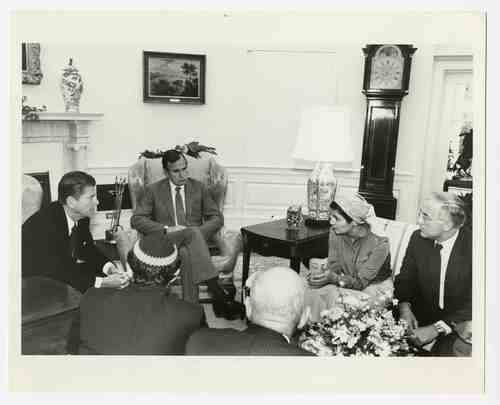
Poster from the Union of Councils for Soviet Jews Records: “Mr. Gorbachev, before you talk arms, let’s talk bodies.” For the march and rally for Soviet Jews Pre-Summit, December 6, 1987. American Jewish Historical Society.
Thanks to generous support from the National Historical Publications & Records Commission (NHPRC), the Center for Jewish History began digitizing more than 75,000 objects from the American Jewish Historical Society’s Soviet Jewry collections in January of this year.
The Gruss Lipper Digital Lab’s staff of seven photographers and technicians has been working hard in the first six months of the initiative, and expects to create 75,100 images and 500 hours of digital audio files by the end of the Digitizing American Soviet Jewry Movement Collections initiative.
Among the collections’ objects are political posters, photographs, trip reports, ephemera and audiocassettes. Each object goes through a meticulous process of digital capture, quality assurance, post-production, metadata enhancement and ingest into the Center’s Digital Collections OPAC. The lab’s equipment includes Canon DSLR cameras, Epson flatbed scanners, a Tascom audio workstation and a Better Light camera for oversized and fragile materials.
In addition to processing the records of organizations such as the National Conference on Soviet Jewry and the Bay Area Council for Soviet Jewry, the digitization team is processing material from such noted figures as Avital and Natan Sharansky and a wealth of American human rights activists.
The American Soviet Jewry movement emerged from small grassroots groups of students and others outside the establishment in the early 1960s. It evolved into a worldwide phenomenon throughout the early ‘90s, and was integral to the emigration of hundreds of thousands of Soviet Jews who had been forbidden to embrace any part of their cultural and religious traditions throughout the Cold War era.
Anatoly (Natan) Sharansky

Ronald Reagan, George Bush, Sr. and Avital Sharansky in the White House during Natan Sharansky’s imprisonment. Image from the National Conference on Soviet Jewry Records. Photographs: Avital and Natan Sharansky. American Jewish Historical Society.
A definite highlight among the photographs digitized thanks to the NHPRC grant is a cluster of photographs from the National Conference on Soviet Jewry Collection titled “Sharansky, Anatoly (Natan) and Avital with Milgrom, Ida (82 digital images).”
Anatoly (later Natan) Sharansky, a prominent Israeli politician and author, and a former Soviet Jewish Prisoner of Conscience, became an icon of the American Soviet Jewry Movement. During his imprisonment, his wife, Avital, and the American Soviet Jewry movement organizations orchestrated a massive public campaign on his behalf and on the behalf of other Soviet Jewish Prisoners and Refuseniks.
The photographs in the collection date from the late 1970s and ’80s and feature Sharansky before and shortly after his imprisonment, as well as Sharansky’s mother and Avital during their campaign for his release. The photos also feature many American human rights activists and members of the United States government campaigning for Sharansky’s release, including President Ronald Reagan, George Bush, Sr., Bob Dole, Alan Dershowitz, Bayard Rustin and many others.
The Solidarity Sunday for Soviet Jews
A striking example of the posters collection digitized by NHPRC is the poster pictured at the top of this post, calling for mobilization for one of the pivotal events in the history of the Soviet Jewry movement–the Solidarity Sunday for Soviet Jews. The national march and political rally was held on the eve of the Washington, D.C., summit between the Soviet Premier Mikhail Gorbachev and President Reagan.
More than 200,000 participants gathered on the National Mall to demand religious, cultural and emigration rights for Soviet Jews. The Jewish Telegraphic Agency described the event as the "largest Jewish rally ever held in Washington, D.C.” To this day, many see the event as a powerful example of the American Jews of all walks of life coming together for a common cause.
The trip report by Barbara Pfeffer

The first page of photographer Barbara Pfeffer’s USSR trip report. From the National Conference on Soviet Jewry Records. American Jewish Historical Society.
Barbara Pfefferwas a photojournalist whose pictures appeared in Life, People, Town and Country and other magazines; she was also a documentary filmmaker who explored Jewish themes. In 1985, she traveled to the Soviet Union to meet and photograph dozens of Soviet Jewish Refuseniks in their communities.
Pfeffer’s engaging and vivid trip report reveals details of Jewish life in the major Soviet cities of Leningrad, Vilnius and Kiev; chilling encounters with the KGB agents; and general impressions of an American traveler in USSR in the ’80s.
An unusual aspect of her report is that, besides covering the major cities in the European part of the USSR, it also offers a rare glimpse into the unique culture of the Jewish communities in the former Soviet Central Asian republic of Uzbekistan. In the decades following Pfeffer’s trip, the USSR collapsed, Uzbekistan became an independent country–and the Jews, who had lived there since 4th century CE, were almost completely gone. At the time of Pfeffer’s visit, the Jewish community of Uzbekistan was 100,000. By 2007, fewer than 5,000 Jews, mostly elderly, remained.
Barbara Pfeffer’s trip ended unexpectedly–she was deported by the KGB for visiting the homes of Soviet Jews.
The NHPRC-funded Digitizing American Soviet Jewry Movement Collections initiative runs through May 2015. Visit the CJH Digital Collections, and search AJHS and all partner collections at search.cjh.org.

